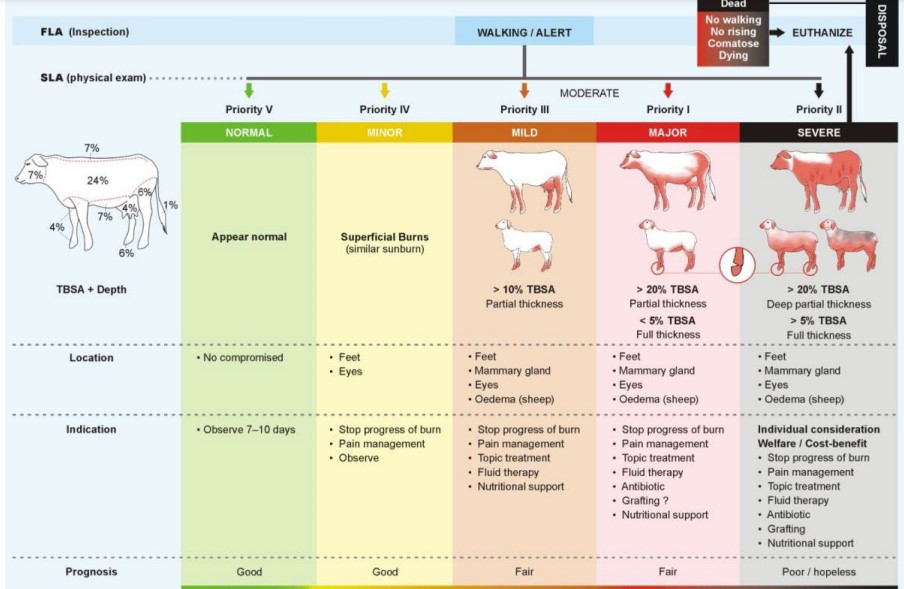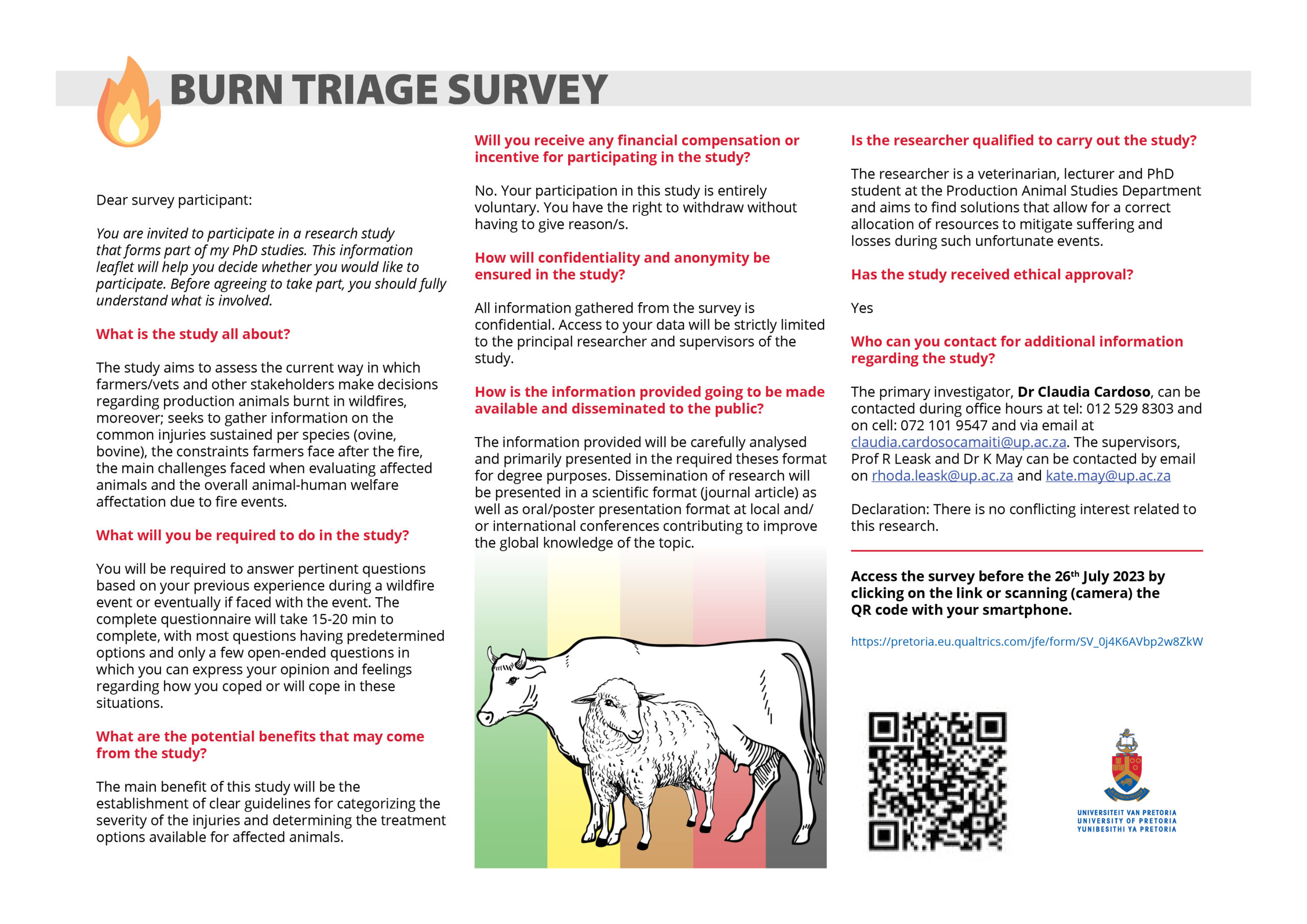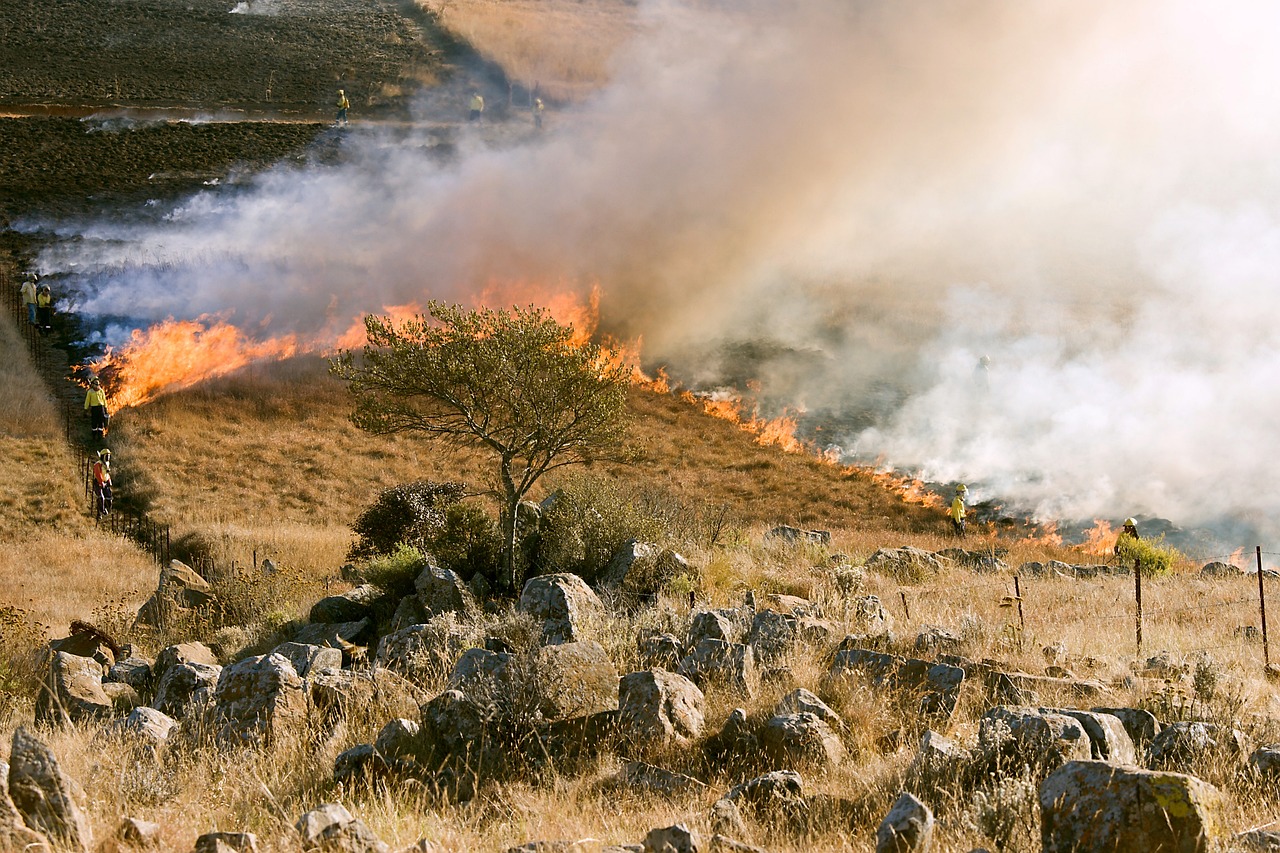By Dr Claudia L Cardoso
Veld fires are common in South Africa and according to local studies will increase in frequency over the next three decades. Farmers are emotionally and financially affected by fires, sustaining losses including feed, facilities, livestock, and future performance of surviving livestock exposed to smoke.
The decision-making process about treating animals affected by fires therefore needs to integrate several factors, including severity of the burn and its clinical prognosis; availability of skilled personnel to care for the animals; adequate shelter, feed, and water; cost of treatment; and long-term consequences for reproductive performance due to smoke exposure.
Offering prognostic hope for moderately burned animals without neglecting their welfare, as contemplated in local legislation, can help mitigate the sense of loss that farmers experience in these situations.
Burn injury in livestock: more than skin burn
Live tissue burns are the most common lesion observed on livestock victims of veld fires. These lesions occur due to direct contact with flames or due to heat radiation from flames. Management of severe burn lesions is difficult due to the type of care and resources needed, costs involved, and the length of the healing time.
Massive loss of fluid and electrolytes leads to shock in animals with partial-thickness burns (second degree) of more than 15% total body surface area (TBSA) and/or more than 5% TBSA full-thickness burns (third degree). Hence, lifesaving intravenous fluid therapy (resuscitation) is necessary in these cases. Moreover, smoke inhalation can severely affect the respiratory system and increase the severity of the burn injury, although it may not be detectable over the first 7 to 10 days.
Assessing the animals and assigning priorities
During veld fires the first challenge is accessibility to the affected area, followed by resources to move animals to safer ground. The first approach in such situations would thus be to visually identify animals that would benefit from being moved to receive care immediately, and those that need to be euthanised immediately (first line assessment/ FLA). At this stage, injured animals will be mainly evaluated on how they present (comatose vs alert) and mobility (can walk vs can’t rise/walk).
Comatose sheep have been reported to have a hopeless prognosis within the first 24 hours, especially if combined with severe burns on lower legs and heavy swelling on the head and front limbs. In general, burned animals with an inability to stand and move have been correlated with poor survivability, hence euthanasia is indicated.
It is important to bear in mind that, in most cases, treatment will be done based on veterinary resources available on a mobile setting; this means identifying animals with the best chance of response to treatment is a priority.
Thereafter, a more detailed treatment plan can be developed according to the evolution of the patient.
Clinical signs to consider in second-line assessment (SLA)
The second stage would be to physically examine animals identified as possibly benefiting from treatment intervention. Some will be in burn shock, need intravenous fluid, and have respiratory affectation, although this process can take up to two weeks to be evident. Farmers should seek veterinary advice regarding treatment needs to make cost-effective decisions.
Evaluation of burn lesions: extent and depth of visible lesions
When evaluating burn lesions, it is important to determine the extent and depth of the burn body surface, which will provide an indication of the severity of the injury and will help in determining the case prognosis.
The following anatomic areas have been defined as percentages of the total body surface: head 7%, back 7%, left costal wall + left abdominal wall 24%, right costal wall + right abdominal wall 24%, udder 4%, ventral thorax and abdomen 7%, each foreleg 4% (8%), each hindleg 6% (12%), perineal area 6%, and tail 1%.
Survivability of the animals is associated with the percentage of body affected, and decreases with the extent of the
burn:
– 10-20% TBSA partial-thickness burns: 100% survivability, although these animals will need basic fluid therapy.
– 20-50% TBSA partial-thickness burns: approximately 87% survivability with intensive care, which will include aggressive fluid therapy, maintaining a clean wound with daily nursing, and pain relief.
– 50-70% TBSA combined partial-thickness and full-thickness burns: 27% survivability under specialist care.
In all cases survivability substantially decreases with smoke inhalation and critical location burns.
Pay special attention to the location of burn injuries
Burn injuries are commonly found in the face, ears, mouth, and lower body (limbs, feet, and udder) in ruminants.
Sheep not shorn will have wool protecting their skin, but bare areas will be fully exposed.
Movement-restrictive lesions on the limbs, such as affected claws, prompt the need to provide feed and water within reach, and special soft bedding. Moreover, these can eventually be movement-restrictive for the animal due to scarring constriction once healed.
When reassessing animals, those with more than one lost claw should be euthanised, as the condition is painful and prone to fly strike and/or secondary infections. Hence, damage to the legs is an important indicator of survivability in sheep.
However, burned legs in restricted areas not associated with swelling have been reported to heal with appropriate care in approximately 30 days.
Monitoring body weight is also an indicator of survivability. Endoparasite control in burned sheep under treatment is important, as it can become an added complication due to immunosuppression. Control measures for these ailments should always be considered in the treatment plan.
Cattle feet burns are more serious than in ovine animals. Cattle will not move to eat under these circumstances, hence nursing injured cattle will be a costly and lengthy process. Euthanasia is indicated when the animal shows severely affected limbs and/or no improvement despite treatment, along with worsening body condition.
Burned udders also need special consideration, as they may be important for future performance.
Mature dairy cows affected by teat burns heal quicker and more satisfactorily, with less anatomic distortion and successful return to normal lactation in comparison to heifers. Healing time for extended superficial burns in adult cows is about four months and usually has a good prognosis, although it needs pain management. Partial-thickness burns have poorer prognosis when time for recovery for subsequent lactation (especially in heifers) is three months or less; bending of the teat and obstruction of the teat canal have been reported as a complication in young animals, which makes prognosis poorer. Topical treatment with emollients and antibiotics is advocated, and systemic antibiotics only used in case of complications such as mastitis.

Figure 1: Triage Burns: Ruminants (TBR). Note: Uses the most used predictors of survivability in burned animals: %TBSA, depth of burns, oedema location on first 24 hours (sheep), limbs/feet affectation (sheep and cows), respiratory affectation/SI, mammary gland/age (cow).
First aid for burns
Once established that the animal will be treated, the first action will be to stop the progress of the burn by applying running cold water (not chilled) for about 10 to 15 minutes. This will reduce the temperature of the tissue and stop the lesion progress. Meanwhile, if the case requires it, a qualified professional should open intravenous access to institute fluid therapy, pain, and anti-inflammatory management, as well as systemic antibiotics if required. Cases where there is respiratory affectation need to be evaluated by a veterinarian to decide on the best approach.
After cooling and gently cleaning the burn lesion, apply abundant topical cooling gel, antibiotic cream with aloe vera and/or local anaesthetic, and cover with nylon film to avoid contamination, until the animal can be evaluated by a veterinarian.
Conclusion
Fires will unavoidably become a more frequent occurrence worldwide, hence disaster management preparedness is necessary to contain losses, and a transdisciplinary group of trained professionals should work towards the recovery of the affected community.
Categorisation of burned animals should follow welfare and cost-effective premises, as this is amongst the core considerations in the context of production animals.
Case prognosis based on burn severity is only one of the considerations for decision-making, as other factors – such as location of the burn, smoke inhalation, and availability of resources during recovery – play an important role in the success of the decision.
This approach will greatly reduce losses due to mismatching needs and resources in the aftermath of veld fires.
Kindly refer to the information below in order to complete a burn triage survey before 26 July 2023 by either clicking on the link provided or scanning the QR code with your smartphone.

Source: UP Faculty of Veterinary Science









